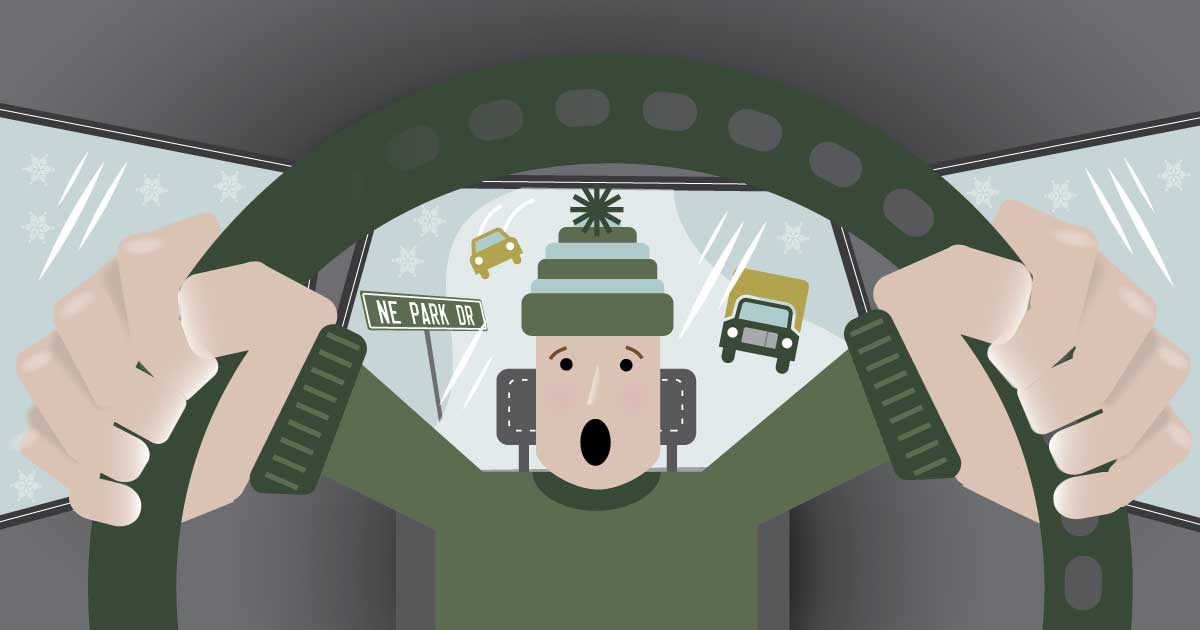
Eastside Fire & Rescues shares 12 tips for safe road travel in winter weather conditions
Driving on snow covered roads can be dangerous! Eastside Fire & Rescue recommends that you avoid driving in these conditions if possible. However, if you need to drive preparing your vehicle and knowing how to maneuver a car on snowy roads is important.
Check out the following suggestions to prepare to take on winter driving conditions safely and confidently.
Tires
Ensuring you have the right type of tires for the winter season is important for navigating snowy conditions. All season or all-weather tires are okay, however, purchasing winter tires is recommended. This is especially important if you live in an area where an inch or more of snow sits on roads below 40 degrees Fahrenheit. This will increase your safety and improve your winter driving experience!
Inspect Tread Depth
As a rule of thumb, tires require a minimum of 2/32 inches of tread depth to be legal. However, that’s not the best model to follow in wintertime. In fact, anything less than 4/32 inches of tread depth is unacceptable. Fortunately, checking your tread depth is very easy and can be done rather quickly. A tread depth gauge is a useful tool for this, but the change in your pockets can work in a pinch.
Take out a quarter or penny. Place the coin in the grooves with Lincoln’s head pointing to the inside of the tire and the backside facing you. If the tread reaches the Lincoln Memorial, you have roughly 6/32 inches of tread depth—and you’re good to go. Using a quarter, follow the same steps with Washington facing you. If the tread just reaches his head, you have 4/32 inches of depth and should have the tires replaced.
*Check your tread depth at least once a month to avoid balding, cupping, spotting and other uneven wear issues.
Snow Chains
Putting snow chains on your tires helps to increase traction, giving you more control of the car. Before the next snowstorm, purchase a set of chains designed to fit your vehicle and practice putting them on your tires. For vehicles with front-wheel drive, put the chains on the front wheels. For vehicles with rear-wheel drive, put them on the back wheels. And if your vehicle is all-wheel drive, put the chains on all the tires (or just the front wheels for better steering traction).
Ready the Spares
Make sure you always carry a spare tire with more than 50 miles on it. Check for dry rot!
Mechanical Checklist
Prepare for a snow event by staying up to date on your vehicle maintenance. This includes steering, brakes, suspension, coolant and wiper fluid.
Tools and Emergency Equipment
Your vehicle should always have a jack, stands, lug wrenches and a first aid kit! It’s also crucial to add an emergency roadside kit with items such as road flares, hand warmers, flashlights, jumper cables and first aid. Now that your vehicle is ready for winter weather conditions, it’s important to practice defensive driving on the road. A slick patch of black ice or an unexpectedly deep patch of snow can send any vehicle into a slide—or worse.
Slow Down
The winter is no time for speeding. When you’re moving too fast, things can get out of control quickly and you will have less time to react. Take your time and stick to the speed limit!
Braking
Brake steadily and lightly when you need to slow down. Remember that braking distances are increased when slush or snow is on the road, and you should begin applying the brakes sooner. If you’re skidding or driving in low-traction conditions, apply the brakes at an even slower rate to prevent the vehicle from going into a spin.
Following Distances
Do not tailgate other vehicles in snow or ice conditions! You will not be able to slow down as quickly as normal, and that may lead to an accident if you’re following too closely. It’s recommended to give a little more following distance than normal.
Approaching Hills
Whenever you’re going uphill, you want to use momentum to your advantage. In other words, you want to hit the hill with enough speed so that light throttle can get you to the top. Applying too much gas will break traction, which you definitely want to avoid. Going downhill is a different story because you shouldn’t apply any gas. You still want the momentum to provide motion, but your right foot should be on the brake pedal, slowly applying pressure to keep you rolling at a manageable speed.
Steady, Deliberate Throttle
Don’t stab the throttle to get up to speed. Instead, use smooth and steady motions to maintain traction. If you do break traction while turning, try to back off the throttle slowly as you correct the vehicle’s trajectory. Rear-wheel drive vehicles will oversteer, meaning the rear end will try to swing out in a turn. You should turn against the direction of the rear end to correct it. Front-wheel drive will understeer, which means it will try to keep going straight. When this happens, easing off the throttle and keeping the wheel pointed into the turn will help you regain traction.
Black Ice
Driving slowly will give you enough time to see the road ahead and identify any dangerous patches of black ice. If you ever suspect that an upcoming spot could have black ice, stop and assess your options. Either drive around the spot (if you find a safe path) or turn around and look for another way to your destination. Keep an eye out for skid marks, stranded motorists or vehicles going at extremely slow speeds. These are important indications that a patch of black ice might be ahead of you.
As published in the winter 2023 issue of Connections >>>
Zak Mohamed is the emergency management analysist at Eastside Fire & Rescue.





